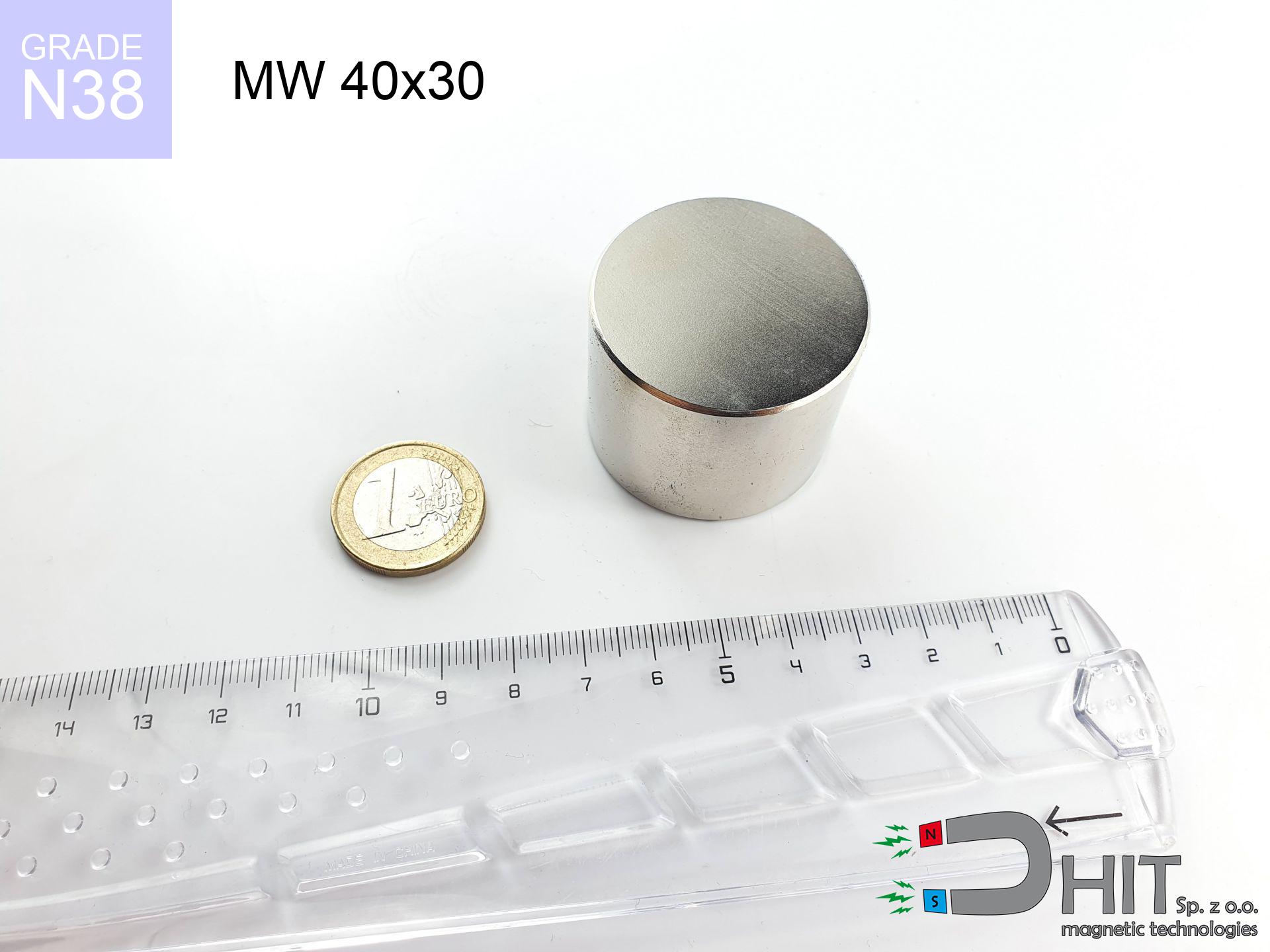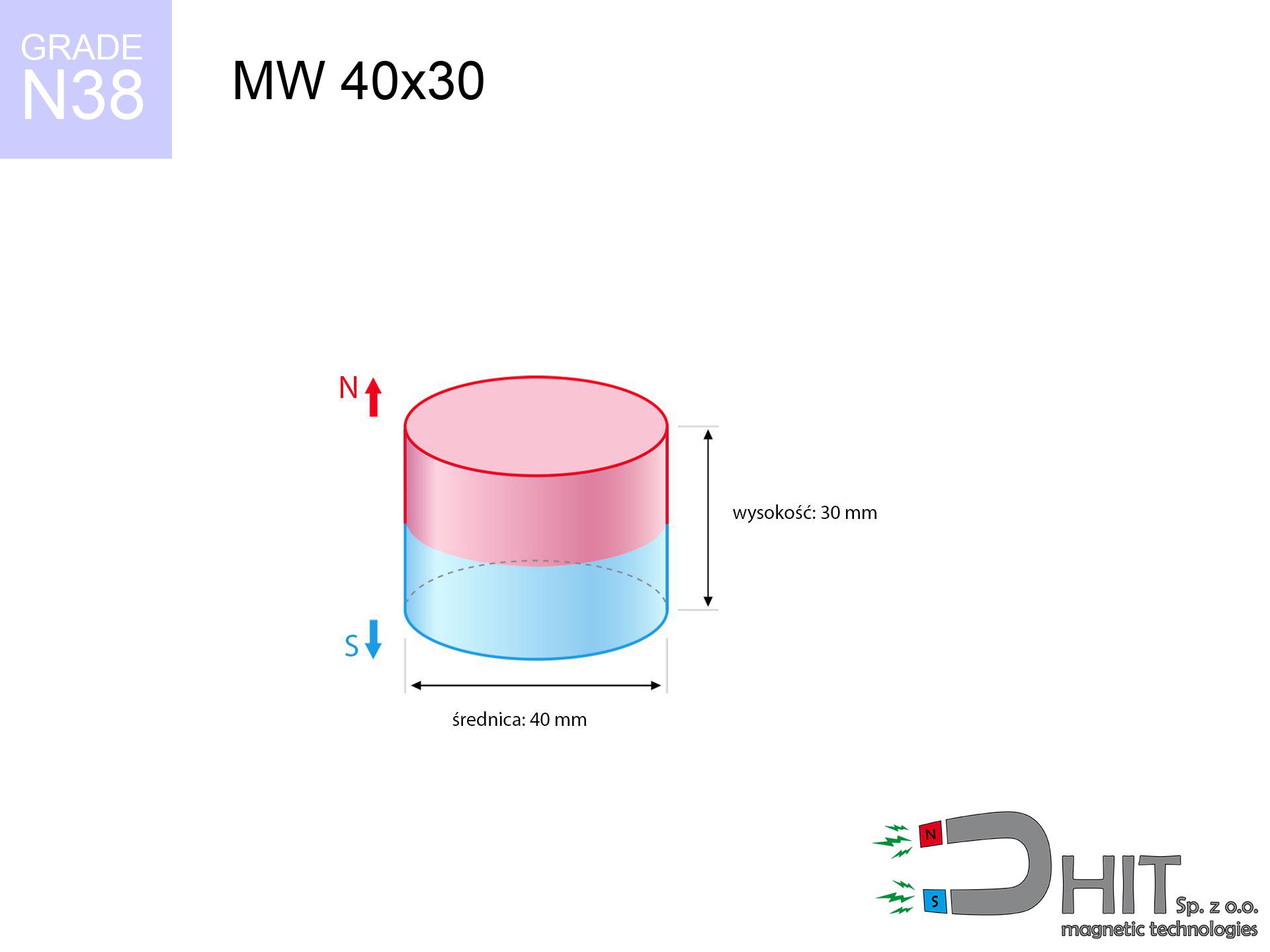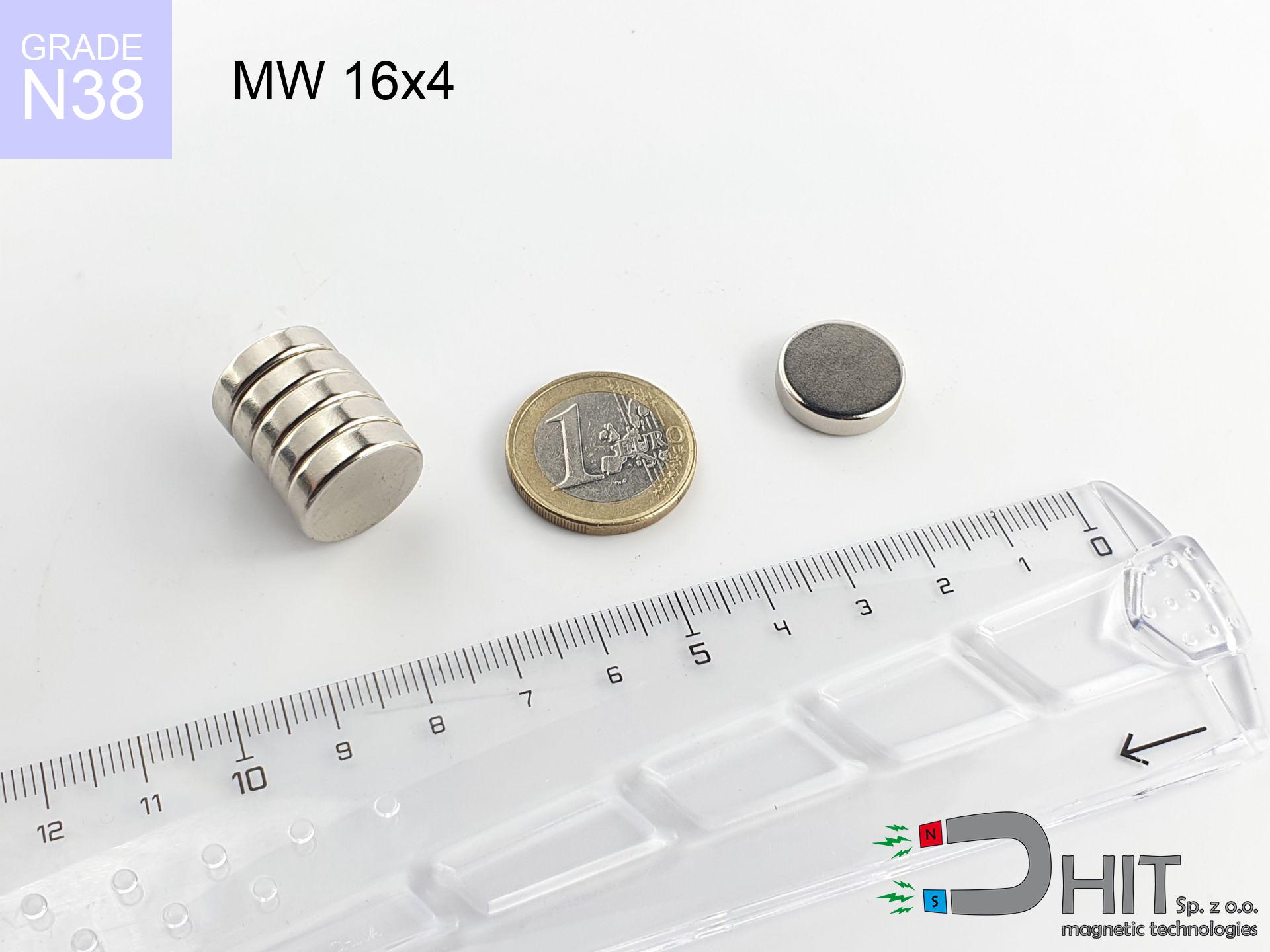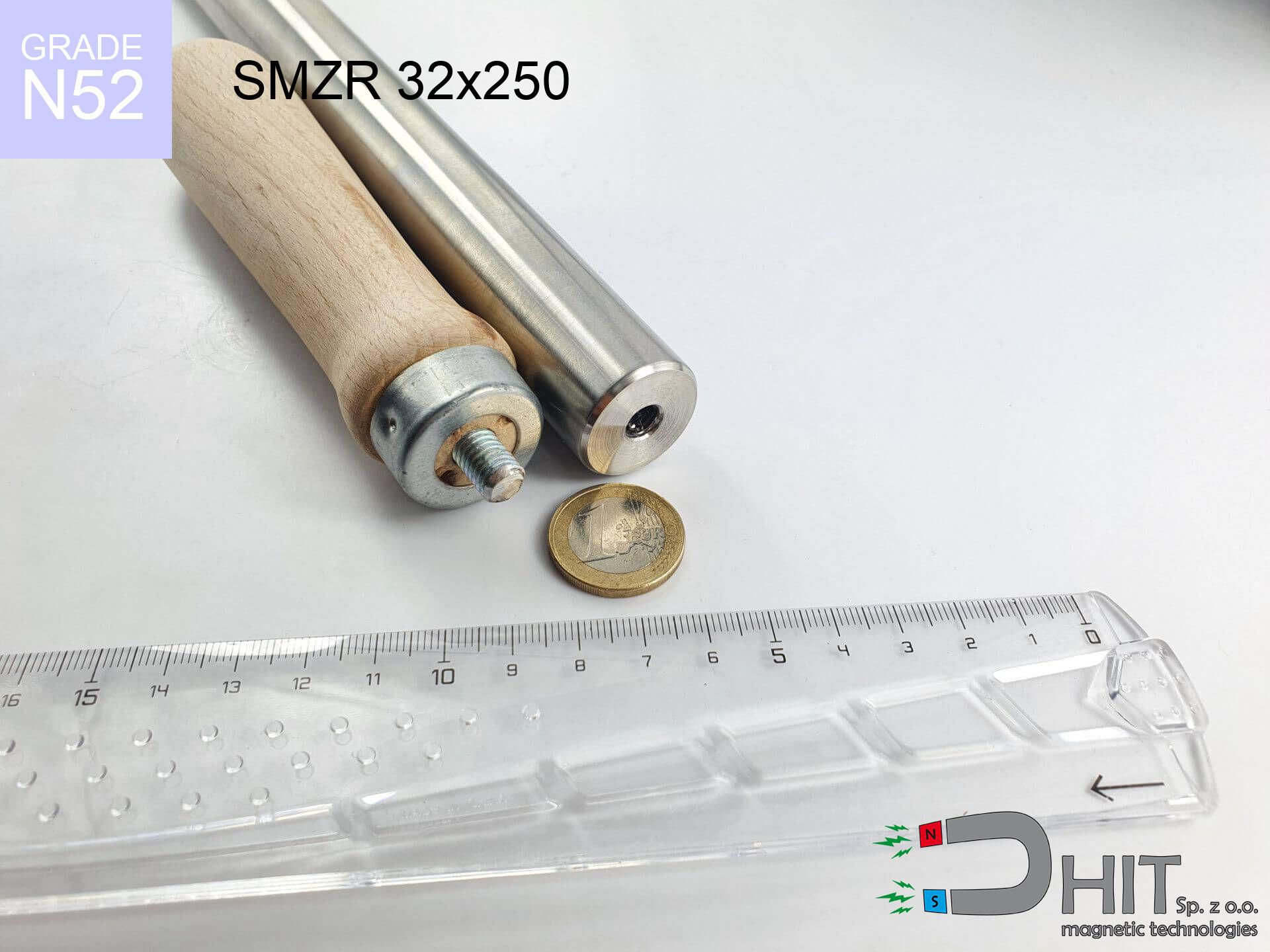MW 40x30 / N38 - cylindrical magnet
cylindrical magnet
Catalog no 010068
GTIN/EAN: 5906301810674
Diameter Ø
40 mm [±0,1 mm]
Height
30 mm [±0,1 mm]
Weight
282.74 g
Magnetization Direction
→ diametrical
Load capacity
54.73 kg / 536.88 N
Magnetic Induction
515.71 mT / 5157 Gs
Coating
[NiCuNi] Nickel
104.80 ZŁ with VAT / pcs + price for transport
85.20 ZŁ net + 23% VAT / pcs
bulk discounts:
Need more?
Pick up the phone and ask
+48 22 499 98 98
if you prefer contact us using
request form
the contact form page.
Force and appearance of magnets can be calculated using our
our magnetic calculator.
Same-day shipping for orders placed before 14:00.
Technical parameters - MW 40x30 / N38 - cylindrical magnet
Specification / characteristics - MW 40x30 / N38 - cylindrical magnet
| properties | values |
|---|---|
| Cat. no. | 010068 |
| GTIN/EAN | 5906301810674 |
| Production/Distribution | Dhit sp. z o.o. |
| Country of origin | Poland / China / Germany |
| Customs code | 85059029 |
| Diameter Ø | 40 mm [±0,1 mm] |
| Height | 30 mm [±0,1 mm] |
| Weight | 282.74 g |
| Magnetization Direction | → diametrical |
| Load capacity ~ ? | 54.73 kg / 536.88 N |
| Magnetic Induction ~ ? | 515.71 mT / 5157 Gs |
| Coating | [NiCuNi] Nickel |
| Manufacturing Tolerance | ±0.1 mm |
Magnetic properties of material N38
| properties | values | units |
|---|---|---|
| remenance Br [min. - max.] ? | 12.2-12.6 | kGs |
| remenance Br [min. - max.] ? | 1220-1260 | mT |
| coercivity bHc ? | 10.8-11.5 | kOe |
| coercivity bHc ? | 860-915 | kA/m |
| actual internal force iHc | ≥ 12 | kOe |
| actual internal force iHc | ≥ 955 | kA/m |
| energy density [min. - max.] ? | 36-38 | BH max MGOe |
| energy density [min. - max.] ? | 287-303 | BH max KJ/m |
| max. temperature ? | ≤ 80 | °C |
Physical properties of sintered neodymium magnets Nd2Fe14B at 20°C
| properties | values | units |
|---|---|---|
| Vickers hardness | ≥550 | Hv |
| Density | ≥7.4 | g/cm3 |
| Curie Temperature TC | 312 - 380 | °C |
| Curie Temperature TF | 593 - 716 | °F |
| Specific resistance | 150 | μΩ⋅cm |
| Bending strength | 250 | MPa |
| Compressive strength | 1000~1100 | MPa |
| Thermal expansion parallel (∥) to orientation (M) | (3-4) x 10-6 | °C-1 |
| Thermal expansion perpendicular (⊥) to orientation (M) | -(1-3) x 10-6 | °C-1 |
| Young's modulus | 1.7 x 104 | kg/mm² |
Technical modeling of the assembly - data
The following values are the result of a physical simulation. Results are based on algorithms for the class Nd2Fe14B. Real-world parameters may deviate from the simulation results. Treat these data as a reference point for designers.
Table 1: Static force (pull vs gap) - interaction chart
MW 40x30 / N38
| Distance (mm) | Induction (Gauss) / mT | Pull Force (kg) | Risk Status |
|---|---|---|---|
| 0 mm |
5156 Gs
515.6 mT
|
54.73 kg / 54730.0 g
536.9 N
|
dangerous! |
| 1 mm |
4900 Gs
490.0 mT
|
49.43 kg / 49432.0 g
484.9 N
|
dangerous! |
| 2 mm |
4641 Gs
464.1 mT
|
44.33 kg / 44334.0 g
434.9 N
|
dangerous! |
| 3 mm |
4383 Gs
438.3 mT
|
39.54 kg / 39538.7 g
387.9 N
|
dangerous! |
| 5 mm |
3879 Gs
387.9 mT
|
30.98 kg / 30981.5 g
303.9 N
|
dangerous! |
| 10 mm |
2773 Gs
277.3 mT
|
15.83 kg / 15826.7 g
155.3 N
|
dangerous! |
| 15 mm |
1946 Gs
194.6 mT
|
7.79 kg / 7792.9 g
76.4 N
|
strong |
| 20 mm |
1372 Gs
137.2 mT
|
3.88 kg / 3877.9 g
38.0 N
|
strong |
| 30 mm |
723 Gs
72.3 mT
|
1.08 kg / 1076.5 g
10.6 N
|
safe |
| 50 mm |
258 Gs
25.8 mT
|
0.14 kg / 137.4 g
1.3 N
|
safe |
Table 2: Vertical hold (wall)
MW 40x30 / N38
| Distance (mm) | Friction coefficient | Pull Force (kg) |
|---|---|---|
| 0 mm | Stal (~0.2) |
10.95 kg / 10946.0 g
107.4 N
|
| 1 mm | Stal (~0.2) |
9.89 kg / 9886.0 g
97.0 N
|
| 2 mm | Stal (~0.2) |
8.87 kg / 8866.0 g
87.0 N
|
| 3 mm | Stal (~0.2) |
7.91 kg / 7908.0 g
77.6 N
|
| 5 mm | Stal (~0.2) |
6.20 kg / 6196.0 g
60.8 N
|
| 10 mm | Stal (~0.2) |
3.17 kg / 3166.0 g
31.1 N
|
| 15 mm | Stal (~0.2) |
1.56 kg / 1558.0 g
15.3 N
|
| 20 mm | Stal (~0.2) |
0.78 kg / 776.0 g
7.6 N
|
| 30 mm | Stal (~0.2) |
0.22 kg / 216.0 g
2.1 N
|
| 50 mm | Stal (~0.2) |
0.03 kg / 28.0 g
0.3 N
|
Table 3: Vertical assembly (shearing) - vertical pull
MW 40x30 / N38
| Surface type | Friction coefficient / % Mocy | Max load (kg) |
|---|---|---|
| Raw steel |
µ = 0.3
30% Nominalnej Siły
|
16.42 kg / 16419.0 g
161.1 N
|
| Painted steel (standard) |
µ = 0.2
20% Nominalnej Siły
|
10.95 kg / 10946.0 g
107.4 N
|
| Oily/slippery steel |
µ = 0.1
10% Nominalnej Siły
|
5.47 kg / 5473.0 g
53.7 N
|
| Magnet with anti-slip rubber |
µ = 0.5
50% Nominalnej Siły
|
27.37 kg / 27365.0 g
268.5 N
|
Table 4: Material efficiency (saturation) - power losses
MW 40x30 / N38
| Steel thickness (mm) | % power | Real pull force (kg) |
|---|---|---|
| 0.5 mm |
|
1.82 kg / 1824.3 g
17.9 N
|
| 1 mm |
|
4.56 kg / 4560.8 g
44.7 N
|
| 2 mm |
|
9.12 kg / 9121.7 g
89.5 N
|
| 5 mm |
|
22.80 kg / 22804.2 g
223.7 N
|
| 10 mm |
|
45.61 kg / 45608.3 g
447.4 N
|
Table 5: Thermal stability (material behavior) - thermal limit
MW 40x30 / N38
| Ambient temp. (°C) | Power loss | Remaining pull | Status |
|---|---|---|---|
| 20 °C | 0.0% |
54.73 kg / 54730.0 g
536.9 N
|
OK |
| 40 °C | -2.2% |
53.53 kg / 53525.9 g
525.1 N
|
OK |
| 60 °C | -4.4% |
52.32 kg / 52321.9 g
513.3 N
|
OK |
| 80 °C | -6.6% |
51.12 kg / 51117.8 g
501.5 N
|
|
| 100 °C | -28.8% |
38.97 kg / 38967.8 g
382.3 N
|
Table 6: Two magnets (attraction) - field collision
MW 40x30 / N38
| Gap (mm) | Attraction (kg) (N-S) | Repulsion (kg) (N-N) |
|---|---|---|
| 0 mm |
205.97 kg / 205965 g
2020.5 N
5 879 Gs
|
N/A |
| 1 mm |
195.99 kg / 195993 g
1922.7 N
10 060 Gs
|
176.39 kg / 176393 g
1730.4 N
~0 Gs
|
| 2 mm |
186.03 kg / 186027 g
1824.9 N
9 800 Gs
|
167.42 kg / 167425 g
1642.4 N
~0 Gs
|
| 3 mm |
176.30 kg / 176302 g
1729.5 N
9 541 Gs
|
158.67 kg / 158672 g
1556.6 N
~0 Gs
|
| 5 mm |
157.67 kg / 157667 g
1546.7 N
9 023 Gs
|
141.90 kg / 141901 g
1392.0 N
~0 Gs
|
| 10 mm |
116.59 kg / 116593 g
1143.8 N
7 759 Gs
|
104.93 kg / 104933 g
1029.4 N
~0 Gs
|
| 20 mm |
59.56 kg / 59560 g
584.3 N
5 545 Gs
|
53.60 kg / 53604 g
525.9 N
~0 Gs
|
| 50 mm |
7.52 kg / 7522 g
73.8 N
1 971 Gs
|
6.77 kg / 6769 g
66.4 N
~0 Gs
|
Table 7: Safety (HSE) (electronics) - warnings
MW 40x30 / N38
| Object / Device | Limit (Gauss) / mT | Safe distance |
|---|---|---|
| Pacemaker | 5 Gs (0.5 mT) | 23.5 cm |
| Hearing aid | 10 Gs (1.0 mT) | 18.0 cm |
| Mechanical watch | 20 Gs (2.0 mT) | 14.0 cm |
| Mobile device | 40 Gs (4.0 mT) | 11.0 cm |
| Car key | 50 Gs (5.0 mT) | 10.0 cm |
| Payment card | 400 Gs (40.0 mT) | 4.5 cm |
| HDD hard drive | 600 Gs (60.0 mT) | 3.5 cm |
Table 8: Impact energy (cracking risk) - collision effects
MW 40x30 / N38
| Start from (mm) | Speed (km/h) | Energy (J) | Predicted outcome |
|---|---|---|---|
| 10 mm |
16.37 km/h
(4.55 m/s)
|
2.92 J | |
| 30 mm |
24.60 km/h
(6.83 m/s)
|
6.60 J | |
| 50 mm |
31.42 km/h
(8.73 m/s)
|
10.77 J | |
| 100 mm |
44.37 km/h
(12.33 m/s)
|
21.48 J |
Table 9: Surface protection spec
MW 40x30 / N38
| Technical parameter | Value / Description |
|---|---|
| Coating type | [NiCuNi] Nickel |
| Layer structure | Nickel - Copper - Nickel |
| Layer thickness | 10-20 µm |
| Salt spray test (SST) ? | 24 h |
| Recommended environment | Indoors only (dry) |
Table 10: Electrical data (Flux)
MW 40x30 / N38
| Parameter | Value | SI Unit / Description |
|---|---|---|
| Magnetic Flux | 65 488 Mx | 654.9 µWb |
| Pc Coefficient | 0.76 | High (Stable) |
Table 11: Underwater work (magnet fishing)
MW 40x30 / N38
| Environment | Effective steel pull | Effect |
|---|---|---|
| Air (land) | 54.73 kg | Standard |
| Water (riverbed) |
62.67 kg
(+7.94 kg Buoyancy gain)
|
+14.5% |
1. Sliding resistance
*Note: On a vertical wall, the magnet holds just ~20% of its nominal pull.
2. Steel thickness impact
*Thin metal sheet (e.g. 0.5mm PC case) drastically weakens the holding force.
3. Thermal stability
*For standard magnets, the critical limit is 80°C.
4. Demagnetization curve and operating point (B-H)
chart generated for the permeance coefficient Pc (Permeance Coefficient) = 0.76
The chart above illustrates the magnetic characteristics of the material within the second quadrant of the hysteresis loop. The solid red line represents the demagnetization curve (material potential), while the dashed blue line is the load line based on the magnet's geometry. The Pc (Permeance Coefficient), also known as the load line slope, is a dimensionless value that describes the relationship between the magnet's shape and its magnetic stability. The intersection of these two lines (the black dot) is the operating point — it determines the actual magnetic flux density generated by the magnet in this specific configuration. A higher Pc value means the magnet is more 'slender' (tall relative to its area), resulting in a higher operating point and better resistance to irreversible demagnetization caused by external fields or temperature. A value of 0.42 is relatively low (typical for flat magnets), meaning the operating point is closer to the 'knee' of the curve — caution is advised when operating at temperatures near the maximum limit to avoid strength loss.
Elemental analysis
| iron (Fe) | 64% – 68% |
| neodymium (Nd) | 29% – 32% |
| boron (B) | 1.1% – 1.2% |
| dysprosium (Dy) | 0.5% – 2.0% |
| coating (Ni-Cu-Ni) | < 0.05% |
Environmental data
| recyclability (EoL) | 100% |
| recycled raw materials | ~10% (pre-cons) |
| carbon footprint | low / zredukowany |
| waste code (EWC) | 16 02 16 |
Other deals
Pros as well as cons of Nd2Fe14B magnets.
Pros
- They virtually do not lose power, because even after ten years the performance loss is only ~1% (according to literature),
- Magnets very well protect themselves against demagnetization caused by external fields,
- A magnet with a metallic gold surface has better aesthetics,
- They are known for high magnetic induction at the operating surface, which affects their effectiveness,
- Through (appropriate) combination of ingredients, they can achieve high thermal resistance, allowing for action at temperatures approaching 230°C and above...
- Due to the ability of flexible molding and customization to custom needs, magnetic components can be created in a broad palette of geometric configurations, which expands the range of possible applications,
- Huge importance in innovative solutions – they are utilized in magnetic memories, electric drive systems, diagnostic systems, as well as technologically advanced constructions.
- Thanks to concentrated force, small magnets offer high operating force, occupying minimum space,
Weaknesses
- They are prone to damage upon heavy impacts. To avoid cracks, it is worth securing magnets in a protective case. Such protection not only shields the magnet but also improves its resistance to damage
- Neodymium magnets lose their force under the influence of heating. As soon as 80°C is exceeded, many of them start losing their power. Therefore, we recommend our special magnets marked [AH], which maintain stability even at temperatures up to 230°C
- They oxidize in a humid environment - during use outdoors we recommend using waterproof magnets e.g. in rubber, plastic
- Limited possibility of producing threads in the magnet and complicated shapes - preferred is cover - magnetic holder.
- Potential hazard related to microscopic parts of magnets can be dangerous, when accidentally swallowed, which is particularly important in the aspect of protecting the youngest. Furthermore, small elements of these magnets are able to disrupt the diagnostic process medical when they are in the body.
- Due to expensive raw materials, their price is higher than average,
Holding force characteristics
Maximum lifting capacity of the magnet – what affects it?
- with the use of a sheet made of low-carbon steel, ensuring full magnetic saturation
- whose thickness is min. 10 mm
- characterized by smoothness
- under conditions of gap-free contact (surface-to-surface)
- under axial force vector (90-degree angle)
- at ambient temperature approx. 20 degrees Celsius
Practical aspects of lifting capacity – factors
- Distance – existence of any layer (paint, tape, air) acts as an insulator, which reduces power steeply (even by 50% at 0.5 mm).
- Direction of force – highest force is reached only during pulling at a 90° angle. The force required to slide of the magnet along the plate is standardly several times smaller (approx. 1/5 of the lifting capacity).
- Wall thickness – thin material does not allow full use of the magnet. Magnetic flux passes through the material instead of converting into lifting capacity.
- Metal type – not every steel reacts the same. Alloy additives weaken the attraction effect.
- Surface finish – full contact is obtained only on polished steel. Rough texture reduce the real contact area, reducing force.
- Heat – NdFeB sinters have a negative temperature coefficient. When it is hot they lose power, and at low temperatures gain strength (up to a certain limit).
Lifting capacity testing was performed on a smooth plate of suitable thickness, under perpendicular forces, whereas under attempts to slide the magnet the holding force is lower. Moreover, even a minimal clearance between the magnet’s surface and the plate lowers the holding force.
H&S for magnets
Mechanical processing
Powder produced during grinding of magnets is flammable. Do not drill into magnets unless you are an expert.
Crushing risk
Danger of trauma: The attraction force is so immense that it can result in blood blisters, crushing, and even bone fractures. Protective gloves are recommended.
Magnets are brittle
NdFeB magnets are sintered ceramics, meaning they are prone to chipping. Collision of two magnets leads to them cracking into small pieces.
Demagnetization risk
Do not overheat. NdFeB magnets are sensitive to heat. If you need operation above 80°C, ask us about special high-temperature series (H, SH, UH).
Nickel coating and allergies
A percentage of the population suffer from a contact allergy to nickel, which is the common plating for NdFeB magnets. Prolonged contact may cause skin redness. We strongly advise wear protective gloves.
Implant safety
Life threat: Neodymium magnets can deactivate pacemakers and defibrillators. Stay away if you have medical devices.
Keep away from children
These products are not suitable for play. Swallowing multiple magnets may result in them attracting across intestines, which poses a severe health hazard and requires immediate surgery.
Threat to navigation
Remember: rare earth magnets produce a field that confuses precision electronics. Maintain a separation from your phone, tablet, and GPS.
Handling guide
Before starting, read the rules. Uncontrolled attraction can destroy the magnet or hurt your hand. Be predictive.
Safe distance
Device Safety: Neodymium magnets can damage payment cards and sensitive devices (pacemakers, hearing aids, timepieces).




![SM 25x175 [2xM8] / N52 - magnetic separator SM 25x175 [2xM8] / N52 - magnetic separator](https://cdn3.dhit.pl/graphics/products/sm-25x175-2xm8-gif.jpg)
![SM 25x350 [2xM8] / N52 - magnetic separator SM 25x350 [2xM8] / N52 - magnetic separator](https://cdn3.dhit.pl/graphics/products/sm-25x350-2xm8-geb.jpg)



